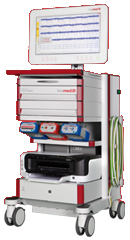|
|
|
|
|||||||||||||||||
|
|
|||||||||||||||||||
|
|
|||||||||||||||||||||||||
PRINCIPLES OF PAIN
|
|||||||||||||||||||||||||
|
|
Definition of pain
|
|||||||||||||||
|
|
Types of pain The cause of pain can be non-malignant or cancerous (malignant). Pain is classified according to the source of injury: ● Neuropathic – injury to tissue of the nervous system ● Nociceptive – injury to tissue other than nerve tissue |
|||||||||||||||
|
|
Neuropathic pain Neuropathic pain is defined as pain initiated or caused by a primary lesion or dysfunction in the peripheral or central nervous system. Neuropathic pain is described as a ‘burning’, ‘tingling,’ ‘shooting’, ‘electric-like’ or ‘lightning-like’ pain. Neuropathic pain may persist for months or years beyond the apparent healing of any damaged tissues. Neuropathic pain is commonly associated with several distinct characteristics. The first is unfamiliar or abnormal unpleasant sensations such as ‘lancing’ or ‘burning’ pain, which are called dysesthesias. Persistent allodynia, pain resulting from a non-painful stimulus such as light touch, is also a common characteristic of neuropathic pain. Partial sensory deficit, for example, diminished perception of certain stimuli such as heat or cold, is also seen in patients with neuropathic pain. Finally, neuropathic pain is characterized by hyperpathia, which occurs when the pain message from a normally painful event is exacerbated so that greater pain is felt. Neuropathic pain can be effectively treated with neurostimulation |
|||||||||||||||
|
|
Nociceptive pain Nociceptive pain is caused by an acute tissue injury or disease outside of the nervous system. It is often an on-going ‘dull ache’ or ‘pressure’, rather than the sharper, trauma-like pain more characteristic of neuropathic pain. Examples of nociceptive pain include sprains, bone fractures, burns, bumps, bruises, postoperative pain, and inflammation from an infection or arthritic disorder. Nociceptive pain can be effectively treated with intrathecal drug delivery There are two types of nociceptive pain (Table 1): ● Somatic nociceptive pain ● Visceral nociceptive pain
|
|||||||||||||||

|
||||||||||||
|
||||||||||||
|
|
|||
|
|
|
||
|


 What’s Up
What’s Up


